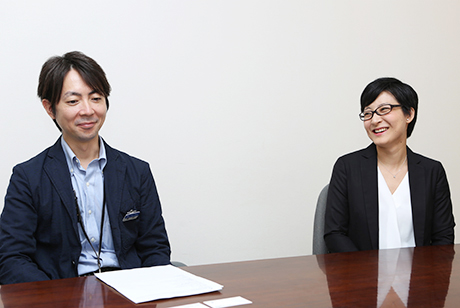Work Style Reform
Planning and Labor Administration Section/Diversity Promotion Section, Human Resources Department
Fuji Electric is making a variety of efforts to establish an environment where anyone can work comfortably. Specifically, with regard to the recent frequent topic of balancing childcare and work, we have taken measures such as revising employment rules and establishing new systems, focusing on ease of work and flexible working styles for women. Ensuring a comfortable work environment for women will lead to a comfortable work environment for men as well. We have conducted some interviews about measures for achieving diversity and inclusion.
Diverse needs for working styles and the need to secure human resources
“Recently, there has been a growing need for diverse working styles, and the trend of seeking ways to balance work and family has been spreading. With Japan’s increasingly serious shortage of human resources, it is urgent that we create a comfortable work environment in order to secure excellent employees.”
This is how Toshitaka Muragishi, Manager of the Planning and Labor Administration Section of the Human Resources Department, explains the background behind the efforts to create a comfortable work environment.
“Our medium-term plan from 2016 to 2018 calls for us to actively advance women’s careers and offer more flexible working styles. We have been considering what measures to take in accordance with this policy.”
In terms of flexible working styles, we have worked to enhance the system from the perspective of work-life balance, including introducing a flextime system, a system for shorter working hours, and initiatives to support employees in balancing work and family, such as raising children and providing nursing care.
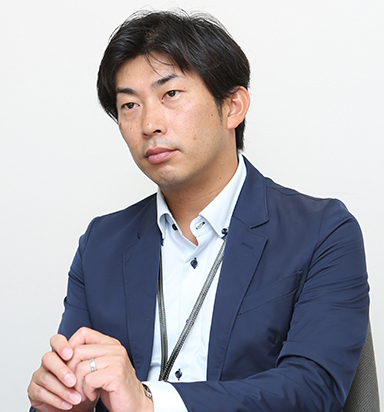
Toshitaka Muragishi, Manager, Planning and Labor Administration Section, Human Resources Department
Shorter working hours eliminate the need for extended childcare hours
While there are a variety of existing systems, we interviewed employees who use the shorter working hours system.
Mika Kano, Sales Section I, Sales Department IV, is currently using the shorter working hours system for childcare. She had her first and second children in 2013 and 2016, respectively, and has been using the system since she returned from childcare leave.
“I work six hours from 9:30 am to 4:30 pm. If I leave work at 4:30 pm, I can pick up my children from nursery school by 6:00 pm. The system is very helpful, as extended childcare hours after 6:00 pm cost extra.”
Kano was originally in charge of sales and often had overnight business trips, but her duties have been modified in consideration of her lifestyle after consulting with her boss. She currently works in-house doing material preparation, numerical management, and support for sales representatives.
Daisuke Katsura, her boss, is understanding of her shorter working hours.
“She has experience as a salesperson, so she comprehends the overall picture of the work and can provide appropriate support, such as with procedures and material preparation. I’m happy that the shorter working hours system means that we can make the most of her skills.”
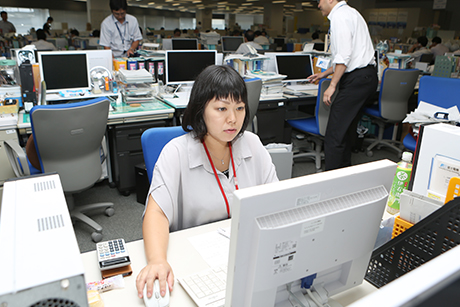
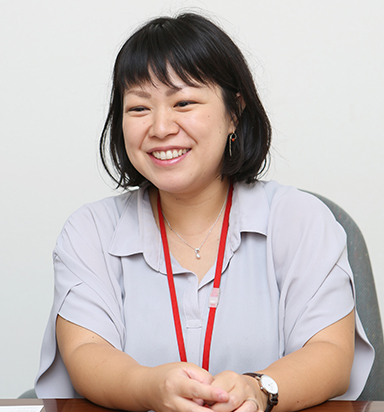
Mika Kano, Sales Section I, Sales Department IV

Daisuke Katsura, Manager, Sales Section I, Sales Department IV
Changes in men's awareness of childcare leave
Such measures involving modifying duties after childcare leave can help to support childcare, but at the same time, people have pointed out an adverse effect: the so-called “mommy track.” Some women return to their jobs to find that the types of work available to them are now limited, or that, despite their intentions, they have been assigned support duties. This puts them at a disadvantage in terms of future career development. Specifically, the current situation in Japan is that women are often expected to bear the burden of childcare alone, so it is only women who tend to be affected by the mommy track, which runs counter to the principle of gender equality.
To solve this problem, we need there to be an expectation for men to be involved in childcare and housework as well. To this end, we have been working on measures to improve the environment, such as creating a culture that makes it easy for men to take leave for childcare and establishing a system for five days of special leave (spousal maternity leave) in addition to paid leave. If this special leave is used in conjunction with the existing paid leave and accumulated leave, men can take part in childcare systematically for a long period of time, which is helpful in promoting male participation in childcare.
“My husband also works for Fuji Electric but he didn't take leave when I gave birth to our first child. But for the second child, he was able to take a month off. I think the maternity and childcare support system works more effectively when both partners use it.”
Kano, who is currently making effective use of shorter working hours, is anxious about next year, when her older child will start school.
“I’m thankful that I can use shorter working hours until my child finishes elementary school, but I don't think it will be the same as when they were in nursery school. Nursery schools assume that parents will be working, which is lucky in a way. But this is not the case with elementary school, and parents are also expected to participate in various events. I have a feeling that things will be more difficult after my child starts elementary school.”
Meticulous support to overcome “the hurdle of first grade”
As explained by Hitomi Nagayama, Manager in Charge, Diversity Promotion Section, Human Resources Department: “In Japanese, we often use the expression ‘the hurdle of first grade’ to refer to the situation.
To help employees overcome this problem, we need to provide meticulous support that is fine-tuned to each stage of childcare.”
“Once children start elementary school, their parents may use the shorter working hours system in different ways, depending on whether they use after-school care, whether their children participate in club activities after school, and other factors, including the age of the children. For this reason, we have given them the option to change their working hours multiple times so the system can be used more effectively.”
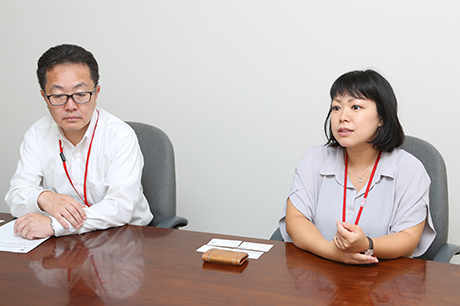
Kano is now pregnant with her third child. She is scheduled to take on maternity leave again from September.
“To be honest, I did initially feel guilty for taking leave, but I don’t anymore because the people around me are understanding of the situation. Fuji Electric has a high percentage of male employees, but I think the company is friendly to female employees as well.” (Kano)
Further enhancing the system by listening to people in the field
Toshitaka Muragishi, Manager of the Planning and Labor Administration Section, goes on to talk about the subsequent enhancement of systems related to work style reform.
“Although we had spent time considering how long people worked, there were no measures in place about where they worked. In June 2017, we introduced the Flexible-Location Working System to allow for teleworking—working from home—and satellite work—working from a location closer to their home than to their place of employment.”
The company had never used this system before, so we expected confusion in workplaces. For that reason, the Human Resources Department decided to facilitate the introduction of the system by initially limiting the range of people who could use it, rather than allowing anybody to work anywhere.
“Initially, we started small and limited the availability of the system to pregnant women and people engaged in childcare or nursing care. Then, six months later, we conducted interviews with the people who had used the system and their superiors to further improve the system.”
This gave us a more detailed understanding of the needs for telecommuting.
“Expanding the scope of telecommuting all at once is not what the people in the field wanted. Some jobs can be done at home, but not all, and many people find that they need face-to-face communication. At the same time, we found that telecommuting was very effective for people involved in childcare and nursing care. There were also calls to make the system applicable not only to childcare and nursing but also family care and treatment of injuries.”
Based on the results of these interviews, the system has been revised to allow employees to work at home while caring for their family members or being treated for their own injuries. Previously, there was a restriction that the period of leave could not exceed half a week, but this has been revised to not exceed ten days per month. This makes it possible to telecommute for a long enough period to meet the demand for intensive use.
Start small and enhance the system while listening to people in the field so we can provide meticulous support. Another reason why this approach was necessary is that what constitutes a comfortable work style may depend on the type of work.
“Many people take it for granted that they will go to the office. I think that, along with enhancing the system, we also need to change that mindset.”
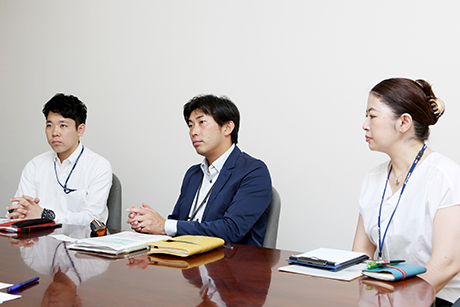
Shotaro Nishiyama, Planning and Labor Administration Section, Human Resources Department (left)
Manager, Toshitaka Muragishi (center)
Hitomi Nagayama, Manager in charge, Diversity Promotion Section (right)
Increasing recognition and awareness to make the system more accessible
Let's take a look at an example of actual use of telecommuting.
Asuka Kobayashi had a child in 2015, took childcare leave, and then returned to work in May of last year. Currently, she uses the shorter working hours system, and also works from home when her child is sick.
Childcare immediately after birth is very different compared to once the child starts elementary school. For example, children up to the age of three or so often develop sudden fevers due to a cold or other reasons. Nursery schools will not allow children to attend when they have a fever, which makes it difficult for their parents to go to work. In principle, telecommuting requires employees to apply by the previous day, so in situations like this, flexible operation is required to fill the need.
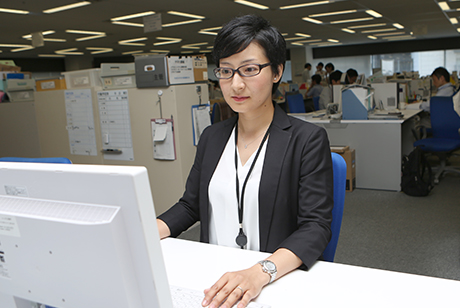
Since it’s common for infants to develop a sudden fever, telecommuting allows their parents to work while still taking care of them even in this type of situation. Telecommuting has fewer users and is much less known than shorter working hours. Many people may be interested in comments from users of the system.
“My child is still small and telecommuting is quite beneficial for me. I can concentrate on my work because I have no incoming business calls. I just have to fight the temptation to take care of housework during my free moments,” Kobayashi says, laughing.
Managing working time is often regarded as an issue when introducing telecommuting. That may not be a big deal, however, as telecommuting is only available to those who have been recognized by their superiors as self-directed.
As a method of working time management, telecommuters are required to e-mail their superiors when they start and end work, and to e-mail the day's work results to their superiors after work.
However, depending on the type of work and the duty assigned, superiors and colleagues may need to be understanding about the day’s work results. Kobayashi says with a wry smile:
“I’m working on things like website revision, which involves not only simple tasks, but also conceptualizing projects. For simple tasks, I can make an objective report—for example, “Today, I covered from here to here.” But when it comes to projects, good ideas don’t always arrive right away, and saying “Today, I spent all day thinking” as a report doesn’t seem good enough. So sometimes I have a hard time getting results.”
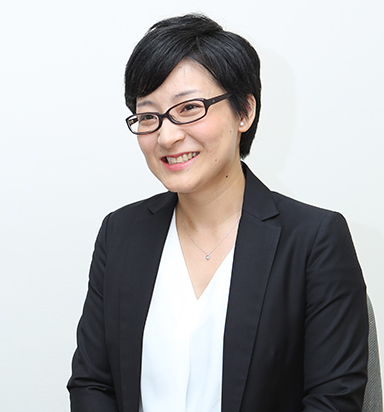
Asuka Kobayashi, Inverter Planning Section, Power Electronics Planning Department I
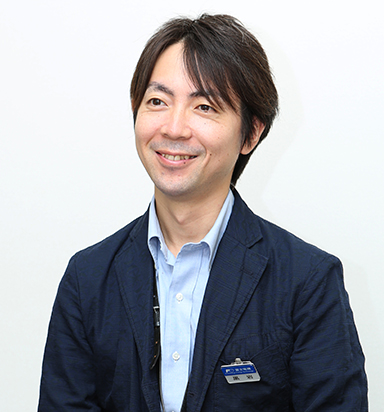
Soichiro Kuroiwa, Manager, Inverter Planning Section, Power Electronics Planning Department I
However, her superior, Soichiro Kuroiwa, says with a chuckle:
“While she herself may be feeling uneasy without any visible output, I understand that her job involves things that do not always produce tangible results immediately. As her boss, I never gave it a thought. (Laughs.) Now I see that there are those kinds of concerns on the user side.”
Kobayashi also shared another view on telecommuting:
“I think quite a few male employees are still feeling awkward about taking leave for childcare. They may find it more acceptable to work from home.”
Following this, Kuroiwa adds:
「“I thought that I would probably use leave and telecommuting for childcare if I had the opportunity. If people in managing positions use the childcare support system, then subordinates should find it easier to use it as well.”
From now on, it will be necessary to make it better known that the company offers a telecommuting system so that both men and women can use it as a matter of course.
Nagayama of the Diversity Promotion Section concludes:
“I think that, in the past year, the awareness of telecommuting and satellite work has changed significantly. What we want is a system that can be used by every employee when they need it—for childcare, nursing care, or treating their own injuries or illnesses—to realize an appropriately-paced work style. In order to achieve such a system, I believe we will need to continue to make improvements.”
